Reading and discussing graphic novels
OMG Check Please! Librarian Jeanie Phillips talks graphic novels with Peter Langella, Vermont librarian, educator and former minor league hockey player and coach. First off the bench: “Check Please!” by Ngozi Ukazu, and how a good coming out story still needs all the other bits. Come for the comics, stay for ways to incorporate graphic novels in the curriculum!
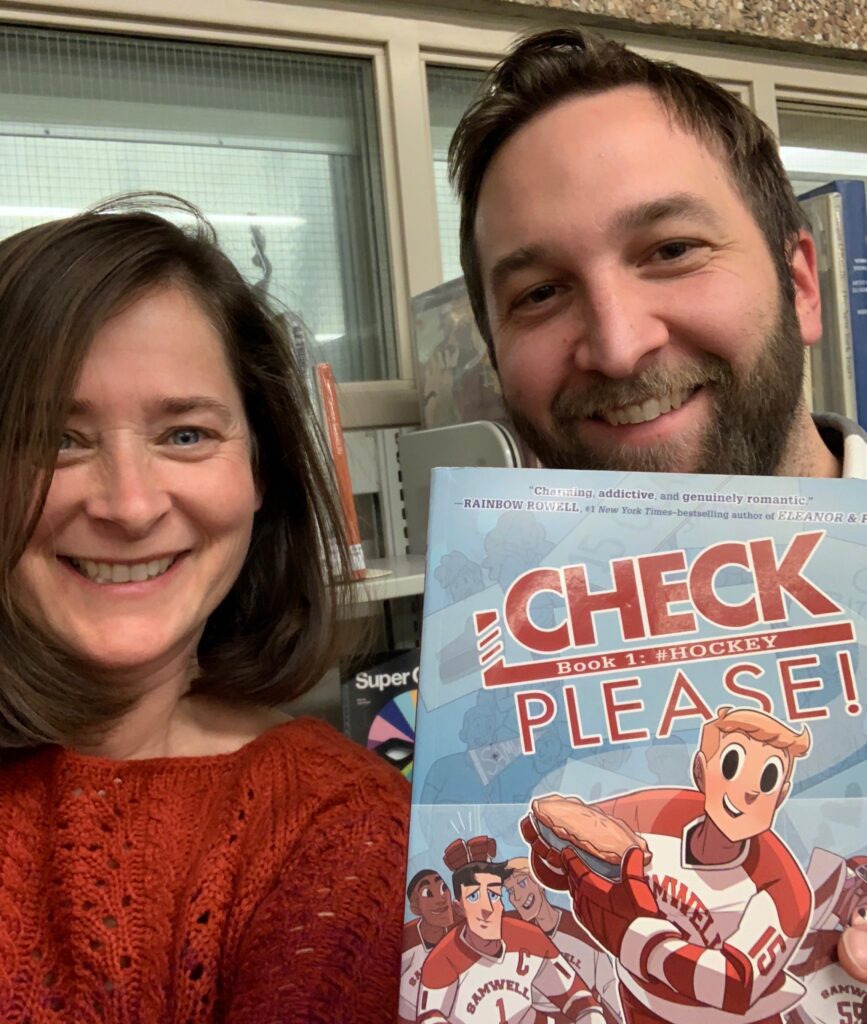
Jeanie: Hi, I’m Jeanie Philips and welcome to the 21st Century Classroom. We’re here to talk books for educators, by educators and with educators. Today I’m with Peter Langella, and we’ll be talking about Check, Please! a graphic novel by Ngozi Ukazu.
Thanks for joining me, Peter! Tell us a little bit about who you are and what you do.
Peter: Thanks for having me, Jeanie. I’m a librarian at Champlain Valley Union High School. And I’m also an English teacher. I’m really lucky here that I get to continue to teach and facilitate English experiences even in my library role. This semester as we’re talking, I’m co-teaching a creative writing workshop class that’s modeled off of graduate-level writing workshops.
My background is in writing. I received an MFA in writing from Vermont College of Fine Arts, focused on children’s and young adult’s literature. I get to play in this balance between the written word and have students read it and see the reactions… And facilitate, and cultivate a love of reading. I really prescribe to the idea that we need to create students who love reading before we can ever get to the point where we create literary analysts and all the other things that we try to make them do.
Jeanie: Am I remembering correctly that you’re a former member of the Green Mountain Book Award Committee?
Peter: Yes, I served on the committee for a few years, and I really enjoyed that experience. There was a lot of reading, but I enjoyed the discussions as we tried to select books that we thought our students would really relate to.
Jeanie: I think I’m also right, that you’re a 2017 Rowland Fellow?
Peter: Yes, thanks for the prompt. I’m part of the 2017 cohort. I’m now in the middle of my second year in the Rowland Fellow experience. My work here at CVU in that capacity revolves around creating more space for interest-based learning, and also investigating how we can change our daily, weekly, and yearly schedules to allow for more student choice.
Jeanie: When I reached out to you with the suggestion that you join me on the podcast, I encouraged you to point me towards any book knowing that you’re someone who steeps yourself in literature for adolescents. You chose Check, Please! Book Number 1 #Hockey. I promptly got a copy and was delighted!
Tell us a little bit about Check, Please!
Peter: Yeah. So before I do that I’ll just say: another little bit about my history which directly relates to why I chose this book and why I love this book so much is that, I spent my whole life growing up playing sports. The sport I concentrated the most on was hockey. I was a college hockey player. I played in the minor pro-leagues in the New York Rangers organization, and then I did some coaching as well. After that finished, I coached at a prep school team in Massachusetts, and I was the Assistant Men’s Coach at Williams College in Williamstown, Massachusetts.
And so, I have this deep love of hockey, but I also have this deep critical life for hockey as well. Because unfortunately in my personal experience, I think a lot of the negative stereotypes that are talked about in a sport like hockey, are in fact true.
Check, Please! by Ngozi Ukazu is about a first year college student named Eric “Bitty” Biddle. Bitty being his nickname that most people call him by. He’s a former junior figure skating champion from Georgia. Bitty is recruited because of his speed and finesse to play on a fictional college hockey team in Massachusetts, at a place called Samwell University. Bitty is small. He’s from the South, and he loves to bake pies. Everything about him means that he is going to immediately clash with his teammates who at first glance seem to be fully entrenched in the so-called “bro culture” that can exist on a team like a college hockey team.
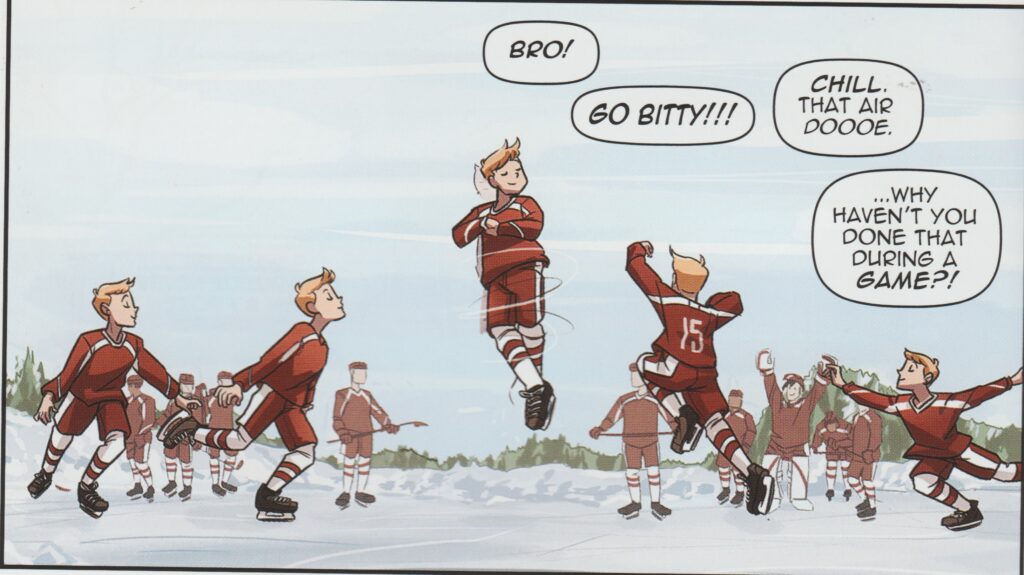
The story really gets started when Bitty starts baking pies. And the reactions from his teammate are not what we might expect. All of the stereotypes and all of the norms that we thought we knew about this cast of characters, starts being flipped. When I first started reading I just couldn’t stop, and I had to know more about all these guys.
It does seem that Bitty is an unlikely hockey hero.
Jeanie: He’s, like you said, small. He hates physical contact, he does not want to be checked, and he cares about things like interior design. He has a video blog, a vlog, where he talks a lot about fashion, baking and his life. All of this makes him really compelling.
Peter: Yeah, his vlog is almost as if he had his own HDTV or Food Network show or something like that. It really intrigued me because I often felt, as a hockey player who had a more academic side I wasn’t really able to be my true self because of the culture. And so I was so intrigued that here’s this character that was able to do that or at least was trying to. Without giving too much away, we find that most of his teammates are very receptive. To accept him as his full self.
Jeanie: Graphic novels are really interesting, because they combine both text and images in really interesting ways to tell a story. I wonder if you could tell a little bit about this graphic novel and how the images and text work together.
Peter: One of the first things I think about is the expressions of the eyes of all the different characters. For example, one of the main characters who’s the captain of the hockey team is Jack Zimmerman. Jack has these raindrop, tear-drop looking bright blue eyes. Whereas Bitty has these elongated vertical dark eyes. Both of them are very expressive — as are the eyes of many of the other characters.
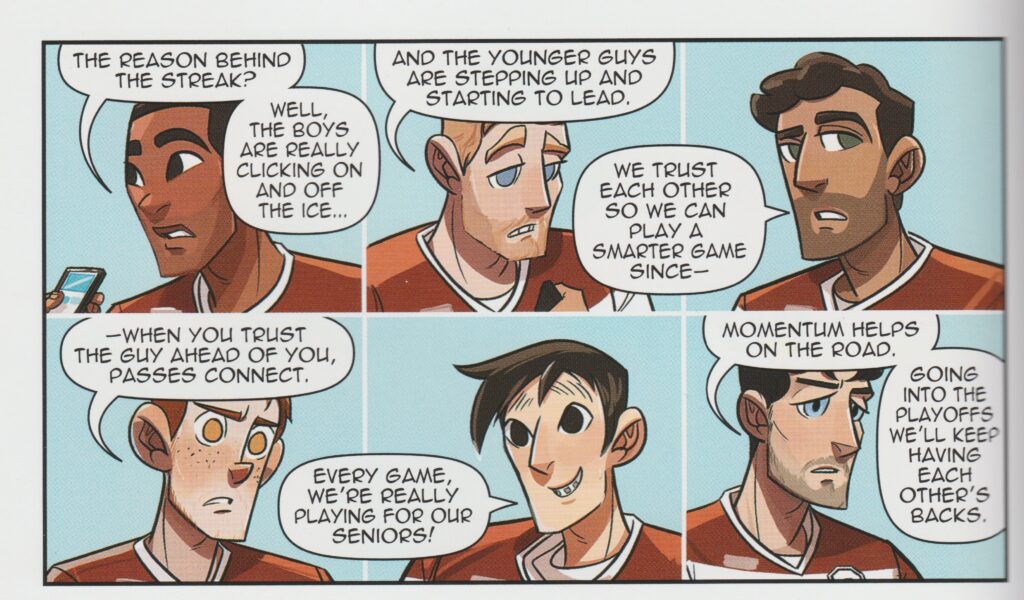
As soon as you flip the page — before you’ve even taken in the rest of the images or the descriptive bubbles or the speaking bubbles in these graphic novel segments — you see the eyes on the page and you immediately know the emotions of the characters. That’s something that an artist like Ngozi Ukazu has an advantage over just prose. The pictures and the words can play off of each other and help the reader get a fuller picture.
Going even further than that, it allows readers at different readiness or interest levels to access the text in different ways.
So some people may be understanding the words but not quite getting the images. Maybe they have trouble reading the emotion. Maybe you don’t see that emotion in the eyes like I just described. There’s still something for you to access.
Then once you get into it and you become a fluent reader with graphic novels, I feel like that inference and that interplay between the words and images can be really powerful. In this particular book, the emotion of the eyes is really what I think I would clue in on right away. It’s even visible on the cover. You see the different eyes and the different characters, and the different emotion that those eyes are just really projecting out on us with.
Jeanie: I love that and that I have also noticed the chins on these “hockey bros” as you call them, they all have such strong jawlines. I think it’s not giving anything away, I think we know as a reader from the beginning of the book, that Bitty is also gay.
This is in fact a coming out story as well.
Peter: Right. I didn’t want to have a spoiler alert, but since you’re the host and you did it, that’s fine. We can go there. He is gay, and his teammates and his friends are very accepting of him coming out. In a way, it’s not the reaction that you might expect at all. When I was first reading the coming out scene, I knew because the characters were developed in a way, that they would be accepting. It even goes further than that, they want to all of a sudden facilitate dates for him. They want to find out exactly what type of guys he’s interested in. It just takes anything that you think might happen and it does the opposite and it takes it to a whole new level.
Jeanie: One of the things I really appreciated about this book is, that the characters were okay when Bitty comes out. Because I have a son that’s Bitty’s age in the book, and I think this book is representative of this current generation. That for whom that is often not a huge issue. It doesn’t mean that homophobia doesn’t sometimes still get in the way for young people? But it’s completely different than we remember it from when we were young.
Peter: I think that’s true. The way that the storyline was flipped in my mind had something to do with remembering people who came out. Especially people who were doing so-called “masculine” activities that maybe felt like it wouldn’t be accepted if they spoke up about their sexual identity. I think that’s absolutely right. I do think that the other thing I like about the coming out thread is that it definitely is the main storyline through the first half of the book. But it’s not the climax.
The book really is about Bitty getting to the place where he can become empowered on the ice, find his place on the ice. And then also find his place at the college.
That has something to do with more than just him coming out. I was like that as well. I’ve had many, many students on the queer spectrum over the past few years talk about: while there are more and more books that do this, they often want a book that is not just about coming out. A book where that can be seen as something that a gay character may do, but there’s so much more to the storyline.
Jeanie: I love that. And I see in this book that Ngozi Ukazu has really embraced the full humanity of all of the characters. There are diverse characters in lots of different ways, whether it’s racial or ethnic identity, their height, their size, their inclinations and interests. I really love that she sees them as athletes and that she sees them as whole people. With diverse interests and important relationships in their lives.
Peter: Yeah. On that thread, there’s an African-American player on the team. That’s something that you don’t see on many hockey teams. It’s a sport that is mostly played in Northern affluent communities. Places that don’t necessarily lend themselves to racial diversity. And to have an African-American hockey player as part of the core group of athletes and friends for Bitty immediately at the beginning of the story? Was a great touch that the author included.
Jeanie: Maybe in part that’s because the author and illustrator is also not what you would expect from a graphic novelist writing about hockey bros in Massachusetts.
Peter: Right.
Jeanie: Can you talk about who Ngozi Ukazu is?
Peter: Yeah. So, Ngozi Ukazu is an African-American woman. And she went to Yale. She happened to be there at a time when the Yale men’s ice hockey team was very, very good, the best they’ve ever been in their team’s history. And she was really intrigued by the fan support that this team had. She was really intrigued by the relationship that the players had and the rivalries the players had with other sports teams on campus. She was intrigued by the deference paid to these athletes. And she really started this comic as a Web comic online as a way to investigate her own personal thoughts about what all that meant, and what that environment meant, that she found herself immersed in.
She created Bitty as a way to shake up that environment. Almost as a thought experiment of what would happen if this were true: if someone like Bitty actually played on the Yale hockey team on the campus where she was studying.
What’s so cool about it is that, Bitty doesn’t exist on the Yale hockey team and maybe never will, right? We’re imagining a world that isn’t quite there yet. So while we do have things like yes, I do think it’s accurate that today’s teenagers are more accepting of someone coming out, but today’s college hockey players or even high school hockey players probably would not be that accepting of a former figure skater from the South who bakes pies. The author and illustrator created this amazing catalyst to explore how people could react. It sets up a vision for a more inclusive sports-world that I personally would love us to get to. And I know many people would, but I don’t know if we’re quite there yet.
Jeanie: Right. How are your students responding to this book?
Peter: The students who have immediately run to this book and most enjoyed it right from the start, are students who… know about the finer details.
- They’re students who enjoy books that have queer characters, and they know about Bitty coming out;
- They’re students who love graphic novels, and really try to read as many of our new graphic novels as possible;
- Or they’re students who know about the whole story and the mash-up of all these ideas.
They know about Bitty serving as a catalyst to be almost a lens for a satirical look at the bro culture and the college hockey culture, and everything that we’ve been talking about. The students who have been a little more apprehensive, are some of the students who I would really like to read this book, because I think this book could serve as a gateway for them.
I sometimes refer to books as “gateway books”, because I think that they can take an emerging reader who maybe isn’t ready to leave their comfort zone of the books that they traditionally like, and go to something that might be a little more complex or feature themes that might be a little more complex for them to investigate.
For example, there are some readers who only read sports books. That would be something that they would self-proclaim. And it’s really hard to get them to read anything else other than a sports book, but this is a sports book in a way.
We mentioned the captain Jack Zimmerman earlier that has the bright blue eyes. He is a hockey superstar. He is someone who is the son of a former Stanley Cup Champion. And he himself might go on to become a National Hockey League star after he finishes college. The descriptions of him and depictions of him scoring amazing goals and having really intense hockey sequences make this is a book that those sports lovers could really latch on to as having amazing hockey scenes.
The reason I call it a gateway book is because then they would also have to investigate all of the themes that are being brought up with the coming out story. With the non-traditional hockey player, with the first glance bros deconstructing their own bro culture and making fun of it as it goes. I would love some more of those students to see this book and be forced through reading it to think about their own views and their own actions. To think about whether or not they too like this future world that that might exist, where this story could actually play out in a real college hockey team and not just on a fictional one.
Jeanie: How do you think your “hockey bro” high school self would have responded to a book like this?
Peter: I actually think I would have loved it, maybe not quite as much as I do now. Because I didn’t even necessarily have the vocabulary to properly know that I was looking for something like this. I definitely was questioning a lot of what was going on. And I knew that there was a problem with the culture of my hockey teams — even if I didn’t know exactly what that problem was. I was looking for something else that no one gave me.
Anything that I was able to find to break holes in that culture? It was it was self-discovery. It was something that I would come across on my own or some realization that I would make my own. Whereas a book like this could have really opened the door for me. And I think it could open doors for a lot of our students.
Jeanie: I love that. I’m also a librarian, and I’m quite certain you’ve heard this next question I’m going to ask you, because I’ve heard a lot from different adults, mostly adults.
What do you say when people say, reading a graphic novel isn’t really reading?
Peter: Yes, I say that they maybe have never read some of these great graphic novels that we’ve read. If they have they would know that that’s not true. I was talking earlier about the interplay between the words and text, and in some ways because of that interplay, graphic novels are actually a more difficult reading experience for students. In order to get the entire story, both with the character development and the plot, you need the words and the pictures. If you’re only accessing one of those, you’re only getting part of the story.
In order for a teenager say, to take in all the words, all the pictures, make the inferences needed to connect those, and also to fill in the gaps between the gutters on the page? (A gutter is the story stops, the frame changes, the chapter changes, some transition). The transitions can be a lot more stark than they are in descriptive writing. And being able to do all that in your mind is a really high level reading skill.
Annual Reminder that Graphic Novels are "Real" Reading: https://t.co/k81SNFPbIQ pic.twitter.com/f7n8zwLqjW
— Book Riot (@BookRiot) June 12, 2017
Jeanie: Also the vocabulary in a graphic novel, is almost always much higher than in an equivalent novel or nonfiction text, I found.
Peter: Yes, I have I found that too.
Jeanie: I’m not sure my son would have learned to read if it weren’t for Calvin and Hobbes. I have a great fondness for graphic novels, in that they serve as a tremendous bridge. Especially, I found for boys or for reluctant readers who maybe need a little extra something whethe rit ‘s Calvin and Hobbes, or the Bone Books or some other graphic novel that really appeals to them.
Peter: No, I agree. That’s this door opening that I talked about for hockey players, or any teenager who is looking for a more action-based experience. Graphic novels can really open that door, in a way that is not “easier”.
I think that’s part of the mistake that some educators might make. They think that because these reluctant or emerging readers are willing to try them, that it must be easier?
I think we’re not giving those students enough credit, and that it’s not easier, but it is accessible because you can do half of the work by just looking at the pictures. Then what it does is it helps those students realize that,
“Oh, I need to take in the words to get this whole story.”
I guess the access point might be easier, easier being just that it’s easier to look at a picture than it is to physically read say the first chapter of a novel. But not easier in that in it’s easier to comprehend the whole text.
https://twitter.com/JuddWinick/status/657004549207552000
Jeanie: I think those pictures really give students some intrinsic motivation to decode the text, right?
Peter: I agree, yes, yes.
Jeanie: Have you had any teachers here at CVU use graphic novels with students?
Peter: We have had some teachers use graphic novels.
They’ve mostly though, been in a real analytical way. We haven’t really had teachers use graphic novels in a way that allows students to… investigate their own thoughts about the reading experience. I’ve been trying to institute more choice- and theme-based reading units here. I’ve had a little bit of success, but not as much as I’d like. Where students are able to choose any text; and then the unit or the lesson is designed in a way that all students can bring evidence from the texts they chose to the discussion.
You can do a unit on identity, or race, or culture, or even something completely different, like resilience. Then students are able to read anything and then come and be part of the discussions. But I found that many educators are also still requiring things like: “Include a descriptive passage that has symbolism and imagery.” And some of the graphic novels only have words when the characters are talking to each other. All of that symbolism and imagery might be there, but they’re in picture form.
Some educators might say, sure you could read a graphic novel, but the lesson and the unit is still not designed in a way that’s completely inclusive of [student] choices.
Jeanie: First, I just want to go back to the class you’re describing that you teach? It’s just sounds so tremendously personalized. Like, where kids get to select the reading that is most relevant or resonant for them, and then pursue whatever themes through that text. That just feels like the far right end of the personalized continuum, so I want to applaud that. I think that’s wonderful.
I hear what you’re saying about how our instruction hasn’t always kept pace with the new formats for books that are out there. Particularly for graphic novels.
Peter: Like for example, and this relates to the question you asked about whether or not graphic novels are easier: that’s some of the only time when they’re brought into a class. So we’re reading Othello, and as a librarian I’ll be asked, “Can you find us 10 copies of the graphic version? So we can give those to our students who are at a lower reading level.” It creates a whole narrative around the comic. Students even feel it a little bit like oh, I’m going to take the easy way out and I’m going to read this.
Jeanie: Well, I just want to contribute to that thinking about Shakespeare in particular. Because I have worked with ninth grade teachers in particular around Shakespeare. Romeo and Juliet, for example. Where the students have read the play, but all students have also read the graphic novel, and the graphic novel is almost like seeing the play. It helped make the play more understandable to them.
Then the students created their own graphic novel versions of scenes from Shakespeare, I found that to be tremendously helpful with texts that are particularly challenging. Not just for teenagers, but for us as adults, too. Shakespeare is not an easy read for most of us.
https://twitter.com/JPhillipsVT/status/811632107328040960
Peter: The two times that I’m immediately thinking of where graphic novels have been used most effectively in class were in tandem with social studies unit. A combined humanities class where you’re reading about a time period and then, you’re learning about a time period and then using the graphic novel to access that time period.
That’s been done really well in a class about conflict and human behavior. They’ve used the famous graphic novel Maus by Art Spiegelman. Some classes here might start using the “March” series by John Lewis and his collaborators to access the civil rights movement. I’m hoping that happens.
If you are a History, ELA, or Writing Teacher and not using the graphic novels March Book 1-3 by John Lewis do your homework! #March pic.twitter.com/BPu41DV0KJ
— Joseph Dickinson (@Mrdsclass33) April 23, 2017
I did also see a teacher who used Watchmen by Alan Moore to investigate the way that filmmakers storyboard. It was a literature and film class. As they were learning how to create films and learning about the storyboarding process, they were using the graphic novel version of Watchmen before they were accessing the movie as a lens toward the storyboarding process. I thought that was a good way to use the book.
As far as just being valued as something that can be read to enhance a person’s own development as a reader, we’re not quite there yet.
Jeanie: I wonder about that as adults. Many of us who work in schools were really good at school. When I think of myself, I’m a reader through and through. For me, graphic novels are not usually my first choice, because they slow me down. They make me read more slowly. I’m kind of an avid reader, and when I can slow myself down, I can really enjoy them. But they’re not what I go for. I wonder how much our bias against them is about our own preference for text?
Peter: I’m going to take this in a teeny different direction, because I think it relates. I read an article where they were basically making the case that we should stop using the term ‘graphic novels’ and we should call these ‘comics’. Because all of them are not novels, per se. There’s nonfiction, there’s biographies, there’s memoirs. They were saying that the reason why people probably don’t is that we’ve invented this term graphic novel to be some somehow equivalent to a novel, right?
People probably felt the term ‘comic’ was too fluffy and not deep enough.
And I think that relates to that question. Because we’re trying to make them equivalent and they aren’t. They’re a different experience. I think when people are accessing them and they have this in their mind that somehow this is supposed to be the same as reading fiction, they’re going to be disappointed. It’s a completely different mental and sensory experience. I’m reminded of that article because it was a false equivalency that was set up by whoever created that term. That has led to some of these questions that we’re discussing.
Jeanie: That’s really helpful. Thank you for shifting the frame on that. Because I’m thinking now about one of my very favorite memoirs: David Small’s Stitches. It’s such a powerful story of his childhood, and not an easy one. It sticks with me; I think about it on occasion. It ranks right up there with any other memoir without any images as a really powerful and intense and illuminating life story. I appreciate that shift. I’m going to think more about that.
I wonder have you ever worked with an art teacher with graphic novels at all?
Peter: Actually I haven’t, that’s a great idea. I would love to at some point, yes.
Jeanie: There’s so much great art. It’s not just the text or the story, there’s so much great art in this book in particular, and in many of the graphic novels we’ve named already. I wonder what it might look like for classroom teachers or librarians to collaborate with art teachers around the visual literacy required to read the text or to create your own graphic novel.
Peter: I’ve helped students gather resources for independent projects, where they’ve been interested in creating their own. Even if not a full text, they’ve created a few panels or a chapter short story in a graphic medium. That’s been fun to help them access their learning. It would be interesting to develop more of an intentional partnership with the art department.
Jeanie: What are some other favorite graphic novels?
Peter: One of my all-time favorite graphic novelists is Gene Luen Yang. Gene Yang’s most famous book was American Born Chinese, which came out in the mid-2000s. It’s interesting that I really like that book, because it relates to Check, Please! in a way. It’s really a satirical look at identity and stereotypes. It’s about a young Asian American who is feeling like he’s not really Asian and he’s not really American. He doesn’t really know what that means, and everyone around him seems to have an idea about who he is.
It’s told in these three different storylines: his everyday life, this other storyline that is based in Chinese folklore about a monkey king, and the third is a real overtly satirical look at the way Chinese Americans were, and especially Chinese immigrants have historically been perceived in this country. Then it all leads toward an awakening of him being able to come to his own understanding finally of who he is. I think that directly relates to Bitty being able to navigate this world of hockey culture, and this New England elite college campus and find his own path, and then be able to feel comfortable in his own skin.
I really love Gene Yang’s work. He has a few others I like. I really, really like a superhero series that’s come over the last few years called the Ms. Marvel series by G. Willa Wilson.
Jeanie: That’s a pretty special series, I love Ms. Marvel too. Tell us about her.
https://twitter.com/dianascarol/status/1072187864740491265
Peter: The traditional Ms. Marvel in the world of Marvel Comics, is kind of your stereotypical blonde Amazon looking superhero. What happens here is that the story starts with a main character named Kamala Khan. She is a teenage female Muslim in Jersey City, New Jersey.
She’s kind of not really sure what her path in life is. She wants to break away from her strict family, but she also cares about her family. It’s another one of these identity stories, where she’s not really sure what her path should be. Then, as often happens in superhero stories, the powers from Ms. Marvel, are transformed in a way that Kamala Khan is able to take on the persona of this superhero.
She then not only has to navigate this world but also being a superhero at the same time and fighting the never ending battle for good and evil.
It’s really a fascinating look at all that through the lens of a superhero story. That’s been one of my favorites over the last few years as well, and then many of our students have really loved that.
Jeanie: Yes, my students at Green Mountain really love that. It’s so playful and yet powerful at the same time. I love when she’s trying to figure out what her superhero costume will be, she has to make those tough choices. One of my favorite recent graphic novels is The Prince and The Dressmaker by Jen Wang. Have you read it?
Peter: I have, yes.
Jeanie: it’s such a fairy tale of a graphic novel.
Peter: The thing I loved the most about the Prince and The Dressmaker too is that, it reminds me of some of the more recent fairytale stories that have been created like, The Princess Bride or Stardust by Neil Gaiman, in that they’re not retellings you know.
Many fairytales are retellings. There are several that kind of stand out as being so original, yet so timeless at the same time. The world building is amazing and it just sets up an entire universe that you can just imagine yourself living in. I think it’s really well done.
Jeanie: The playfulness of the Prince and The Dressmaker reminds me of a graphic novel that was on the Green Mountain Book Awards list a couple years ago called Bandette. It was about a French girl Robin Hood figure almost, right? Do you remember that one?
Peter: I do. The thing that immediately comes to mind is the Oceans series of movies. Often in these Oceans movies they’re thieves and Bandette is a thief, just like Robin Hood. She is kind of a stealing something so that the bad people can’t get it first. Stealing something because it helps the common good, and yeah it’s really playful. Those stories were originally I believe published in Belgium and it’s a from the French speaking part of Belgium, and so there’s really a different sensibility to the whole story that’s from the European thread of comics.
The closest thing I could think of are some of the earlier American comics. I’m thinking about the Adam West Batman TV show that almost is making fun of itself. It’s going on with the really overt onomatopoeia and caricatures. Bandette does some things like that, but in a much more sophisticated way.
Jeanie: Another thing that was really popular when I was in the library was Anime. Some kids became really hooked on Anime and would take out everything in a series. Do you find that to be true here too?
Peter: Yes.
I actually have a few students who are helping me develop our Anime and Manga collection.
They’re always sending me recommendations, and I always feel behind. We have purchased quite a few over the last several years, and that’s a growing trend. Students love to devour those books.
Jeanie: That seems like a great recommendation for our educator listeners.
If you want to know what graphic novel you should be reading ask the kids in your class.
Ask young people what they’re reading, and try it out, especially if you haven’t read graphic novels before.
Peter: That’s a great suggestion. That’s how I stay up on it really. Especially with the Anime and the Manga. They are a little harder to find reviews and recommendations for in the kind of the standard publications or places on the internet.
Jeanie: You told me some news as I arrived here at Champlain Valley Union High School. The Morris Award nominees have just been named, do you want to share that with our listeners?
Peter: Yes, so the Morris Award is an award with YALSA, the Young Adult Library Services Association. It’s for the best books of the year by debut authors. “Check, Please!” #Hockey in this form, even though it started on the Web, is Ngozi Ukazu’s first printed publication. It was named one of the five best debuts of 2018 by YALSA.
https://twitter.com/PeterLangella/status/1072538729926008832
Jeanie: That’s an enormous honor. Last year, I happened to be at the Morris Award presentation. I got to see Angie Thomas receive her award for The Hate U Give and to see the other nominees. It’s a tremendous honor for her to be a Morris Award finalist. I wish her well.
Peter: Yes, I’m not completely sure on this, but I think that this is the first comic graphic novel that has ever been a finalist for the Morris Award. That is quite an accomplishment.
One of the things we haven’t talked about yet is the meta cognitive approach to writing graphic novels.
It appears somewhat in this print version but it definitely appears online. Between the different chapters of the comic there are these interludes where several of the characters talk about hockey terms. They introduce the sport in a really fun way to people who might not be that familiar with the vocabulary.
There’s a Twitter account that belongs to Bitty, the main character. While the webcomic was first coming out, the Twitter account was really active. Many of the tweets are added as kind of an addendum to the print form here.
It’s amazing, because the Twitter account is exactly how a real Twitter account would be. There’s this string of tweets all in a row that are maybe really concentrated on one particular issue or an event that’s happening. Then there might be weeks at a time where there’s no tweets. It’s just the meta aspect of that is just something that really is quite rare in books.
Jeanie: It’s also just wicked fun for their reader, right?
I loved the end of the book where you read Bitty’s Twitter feed! I found it endlessly entertaining and was laughing out loud; it felt just truly authentic.
Peter: The author has just been able to create an entire world for these characters to exist in which people love, right?
You love to be a fan of something that you can fully immerse yourself in, and that’s why people love Harry Potter. Now there’s theme parks and Pottermore where there’s more stories, and the universe just keeps expanding. I don’t think there will ever be a Check, Please! theme park, but if there is I would probably be there the first day.
Jeanie: It’s true. She does build a world much like Tolkien or JK Rowling, that you really want to immerse yourself in.
Peter: Okay. Yes, and one thing that’s important to know is that we mentioned how this started as a webcomic. It still is a webcomic. Interested readers can move on from the story, move forward with the story now online. This first book captures Bitty’s first and second year at Samwell University. Online we’re actually now in the middle of year four.
All of year three is there and now year four has begun and is moving towards some really interesting places. It’s really neat because the story also continues on with some of the characters from this first book who have graduated from Samwell. We actually see them in the non-Samwell environment out in the world, which is really exciting and cool.
Jeanie: I think what appeals to me about that as a librarian, as an educator, is that we get to encourage kids to read in different formats. Sometimes adults, I think we’re behind the curve. We may read on our Kindle, right. A lot of our students are reading Harry Potter fan fiction online.
Peter: Right.
Jeanie: This will not seem as strange to them to go online and continue the series there.
Peter: Yeah, not at all. The webcomic really started for Check, Please! in the world of Tumblr. It is a world that I really don’t know that well, have waded into only a few times. Check, Please! being one thing made me wade a little deeper. Many of our students spend a lot of time in these various online worlds when they’re not in school and there’s a lot of great work happening there.
Jeanie: Right. It’s great to give them something really meaningful to dig into in that world too.
Any other recommendations for our listeners? Where might might find great comics or graphic novels to read?
Peter: Yes, so a really great resource is actually the publisher’s website for the publisher of “Check, Please!” It’s called First Second. First Second also has published all of Gene Yang’s books, the author and illustrator mentioned before. On the First Second website, they have amazing resources from their whole backlist. They also have resources for integrating graphic novels into school curriculums, which I think is really great.
I would recommend YA book blogs.
There’s teenreads, Epic Reads, and Fierce Reads. I think that those often give you a more authentic view than a review journal might. A review journal is often quite static. It’s one person’s perspective on a book. They kind of end with their take and that can make or break that book on whether a school or library wants to buy it and have their students read it. I think a lot of the websites have teen bloggers, or college students who are interning. There’s more of a back and forth. Those are going to be put out on social media and they’re going to allow for more back and forth with the actual readerbase and fanbase. Goodreads is a great place to go and get recommendations too.
Jeanie: I just want to say thank you so much for taking the time to sit down with me and talk graphic novels. You know so much more than I do about this media. Thanks for sharing your expertise, and for introducing me to Bitty, I just love him.
Peter: Yes, I do too, thank you, Jeanie. This was great.
Jeanie: It’s a pleasure. Thank you.
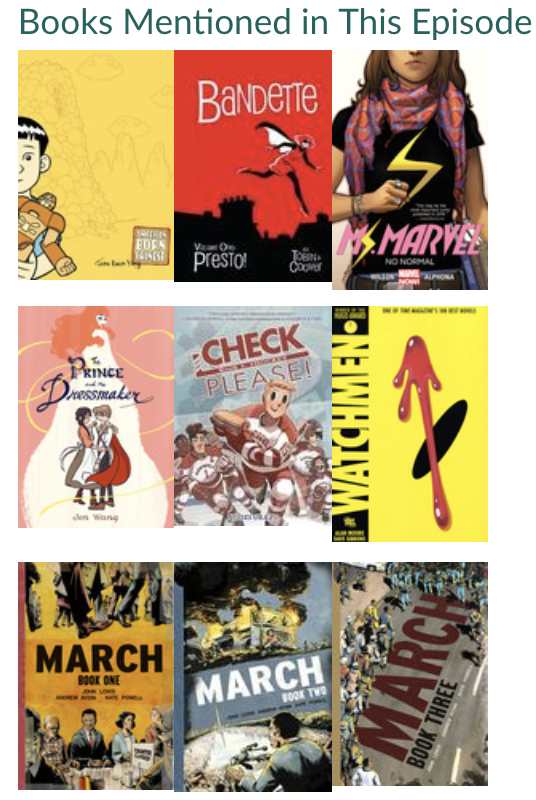


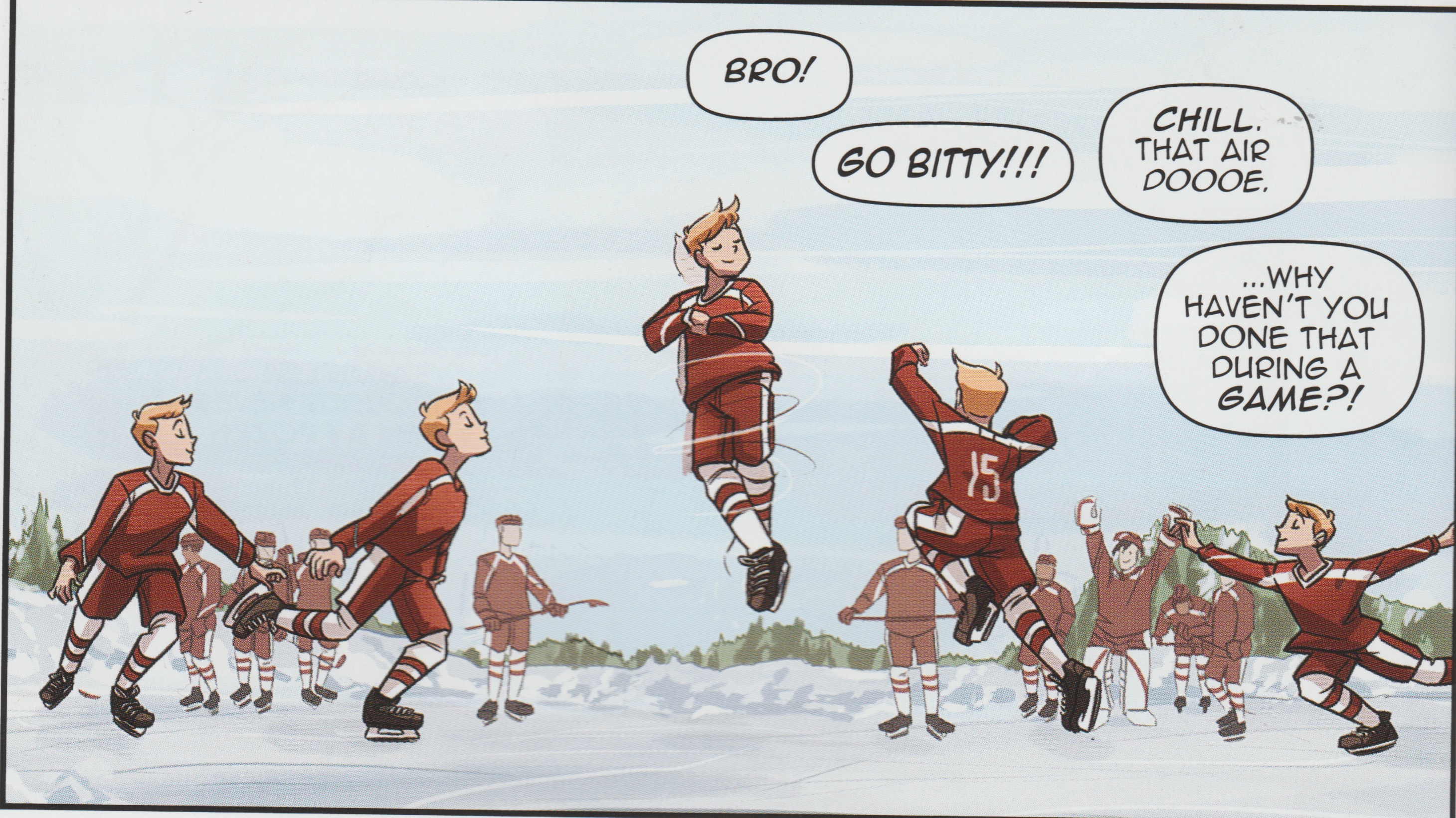
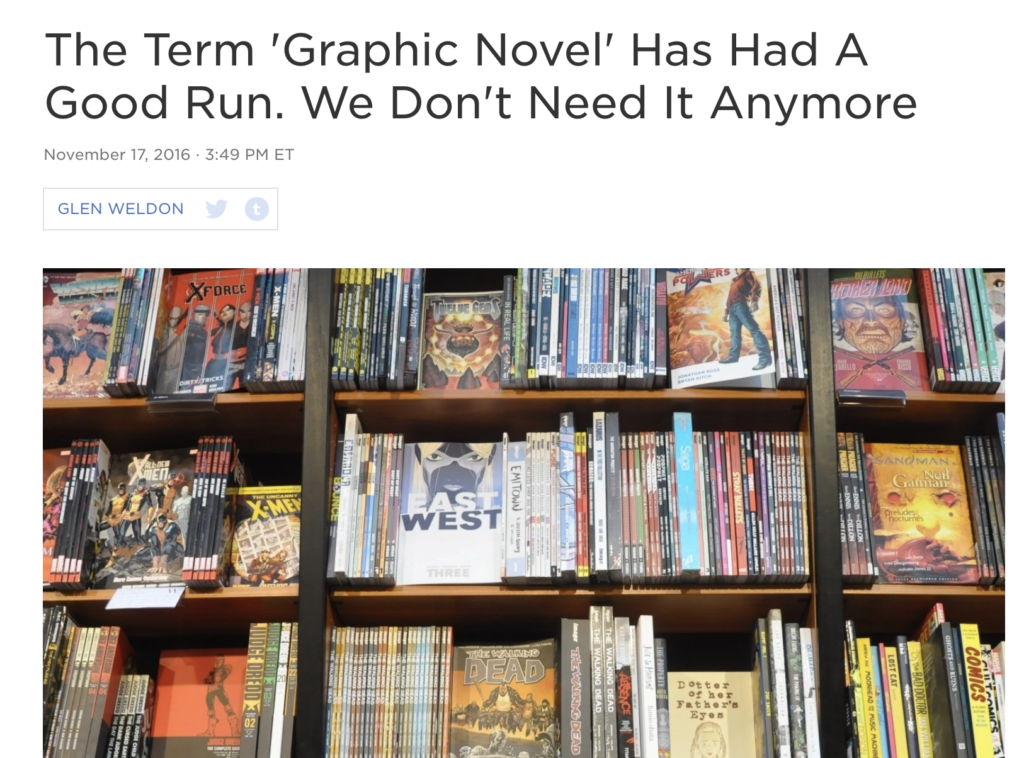
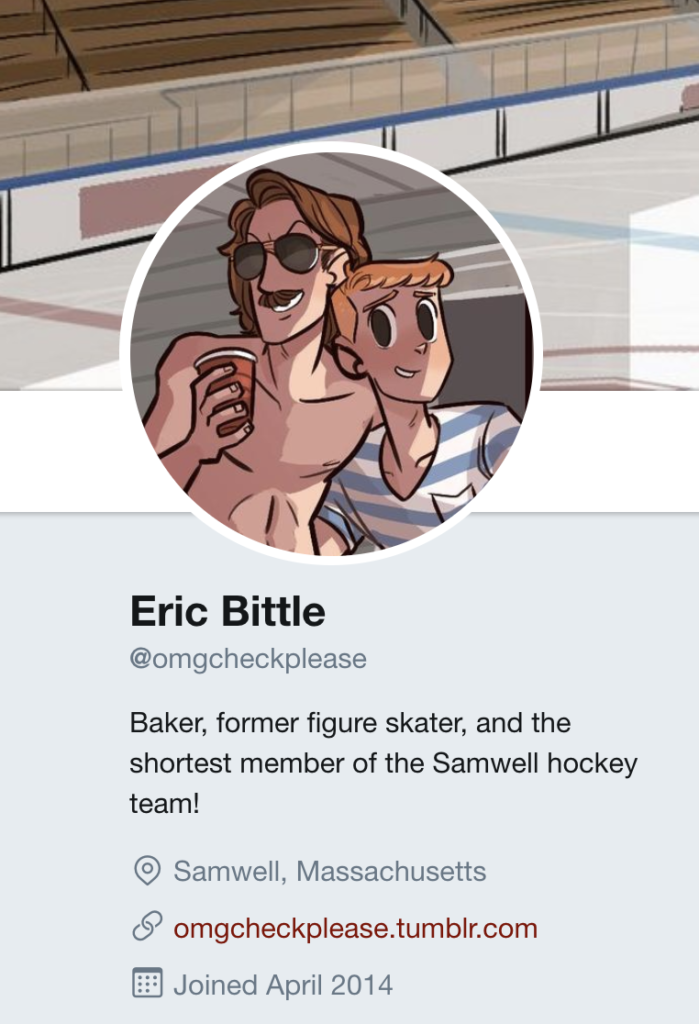
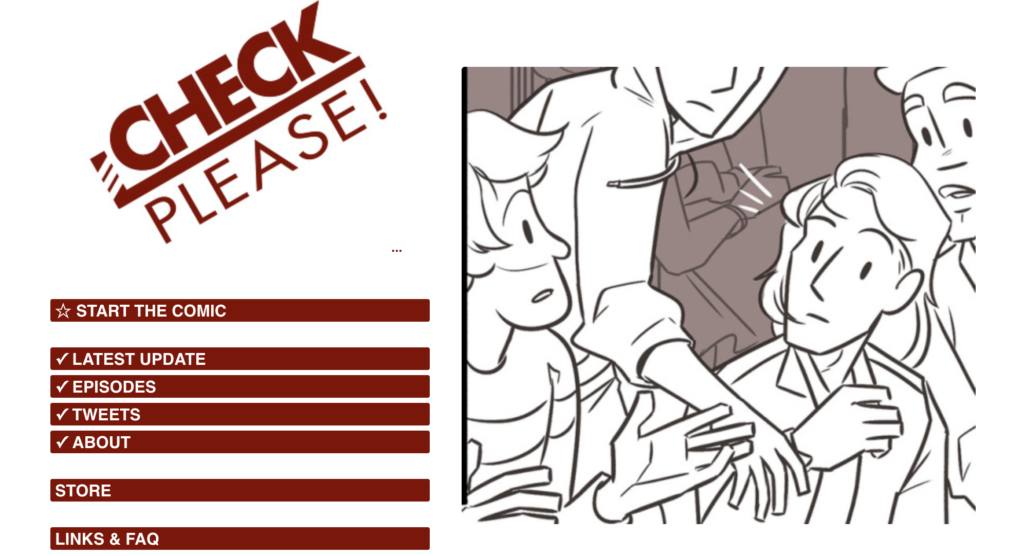
3 Replies to “Check, Please! #Hockey with Peter Langella”
Comments are closed.